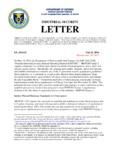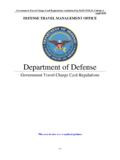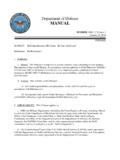Transcription of Department of Defense - National Security Cyberspace Institute
1 Department of Defense CYBER OPERATIONS PERSONNEL REPORT April 2011 Report to the Congressional Defense Committees As Required by Public Law 111-84 i Contents 1. Composition of the DoD Cyber Operations Workforce .. 2 Dynamic Structural Change within the Department .. 2 Changing Work Roles and Occupations within the IT/Cybersecurity Community .. 3 FY09 Cyber Operations Workforce .. 3 Sufficiency and Balance in the Cyber Operations Workforce .. 5 The State of Cyber Operations Personnel Outside of DoD .. 7 2. Career Progression and Professional Development .. 10 Occupational Fields .. 10 Career Paths .. 14 Training and Development .. 18 3. Recruitment and Retention .. 25 Civilian Recruitment Authorities and Incentives .. 26 Civilian Retention Incentives .. 31 Military Recruitment Incentives .. 34 Military Retention Incentives .. 36 Recruiting and Retention Standards and Measures.
2 37 Recruiting and Retention Challenges .. 37 4. Academic and Cyber Outreach .. 41 DoD IT/Cybersecurity Academic Outreach Programs .. 41 Maximizing Collaboration to Develop a Skilled IT/Cybersecurity Workforce .. 45 New Initiatives Underway to Develop and Attract Future Cyber 50 ii 5. Creating New Public/Private Initiatives .. 52 Enhancing DoD s Certification Programs .. 52 Forging New Relationships to Strengthen Cybersecurity Capabilities .. 53 Exploring Rotational Assignments with Public/Private Organizations .. 54 6. The Way Ahead .. 56 Recruiting and Retention Authorities .. 56 Compensation .. 59 Training Improvements .. 59 Appendix A Cyber Operations-related Military Occupations .. 61 Appendix B Commercial Certifications Supporting the DoD Information Assurance Workforce Improvement Program .. 65 Appendix C Military Services Training and Development .. 66 Appendix D: Geographic Location of National Centers of Academic Excellence in Information Assurance.
3 79 1 Introduction Section 934 of the National Defense Authorization Act (NDAA) for Fiscal Year (FY) 2010 (Public Law 111-84), provided for the Secretary of Defense to submit a report to the congressional Defense committees that includes a study on the recruitment, retention, and career progression of military and civilian cyber operations personnel. The NDAA directed that the analysis address the sufficiency of the numbers and types of personnel available for cyber operations, including an assessment of the balance between military and civilian positions and the availability of personnel with expertise in matters related to cyber operations from outside of the Department of Defense (DoD); the definition and coherence of career fields for both members of the Armed Forces and civilian employees, including the sufficiency of training and experience levels required, and measures to improve them if necessary; the types of recruitment and retention incentives available to members of the Armed Forces and civilian employees; identification of legal, policy, or administrative impediments to attracting and retaining cyber operations personnel.
4 DoD standards for measuring effectiveness at recruiting, retaining, and ensuring an adequate career progression for cyber operations personnel; the effectiveness of educational and outreach activities used to attract, retain, and reward cyber operations personnel, including how to expand outreach to academic institutions and improve coordination with other civilian agencies and industrial partners; the management of educational and outreach activities used to attract, retain, and reward cyber operations personnel, such as the National Centers of Academic Excellence in Information Assurance Education; efforts to establish public-private partnerships with respect to cyber-related training; and recommendations for legislative changes necessary to increase the availability of cyber operations personnel. The NDAA defined cyber operations personnel as members of the Armed Forces and civilian employees of the DoD involved with the operations and maintenance of a computer network connected to the global information grid (GIG), as well as offensive, defensive, and exploitation functions of such a network.
5 A Department -wide data call to address the requirements of the congressional reporting requirement was launched on July 28, 2010 by the Office of the Under Secretary of Defense for Personnel and Readiness (OUSD(P&R)), as the lead organization responsible for compiling the report, in conjunction with the Assistant Secretary of Defense for Networks and Information Integration/DoD Chief Information Officer (ASD(NII)/DoD CIO), the Under Secretary of Defense for Intelligence (USD(I)), and the Office of the Under Secretary of Defense for Policy. The DoD Components have responded and this report reflects the summary analysis of their responses. The cyber operations workforce is essential to the Department s mission and we appreciate the opportunity to report on the Department s needs and progress in this area. This report discusses the Department s operations and maintenance (O&M), defensive operations and information assurance (IA) workforce.
6 2 1. Composition of the DoD Cyber Operations Workforce Although it is a man-made domain, Cyberspace is now as relevant a domain for DoD activities as the naturally occurring domains of land, sea, air and space. There is no exaggerating our dependence on DoD s information networks for command and control of our forces, the intelligence and logistics on which they depend, and the weapons technologies we develop and field. In the 21st century, modern armed forces simply cannot conduct high-tempo, effective operations without resilient, reliable information and communication networks and assured access to Cyberspace . Department of Defense Quadrennial Defense Review Report, February 2010 This report is focused on FY09 Department of Defense Cyber Operations personnel, with duties and responsibilities as defined in Section 934 of the Fiscal Year (FY) 2010 National Defense Authorization Act (NDAA).
7 It should be understood that during the writing of this report, the Department has, and continues to Institute , dynamic force structure changes within the Information Technology (IT)/Cybersecurity (IT/Cybersecurity) environment which impact the description, identification and development of the military and DoD civilian personnel supporting DoD s cyber operations. The Office of the Secretary of Defense , the Joint Staff, Combatant Commanders and the Military Services all acknowledge that as the cyber domain matures to address current and emerging threats, the workforce roles will also evolve to position the Department with address the continuing evolving threats and missions of the Department . Dynamic Structural Change within the Department In the past decade, cyber threats to National Security have grown exponentially. They are unremitting and when successful, have the capability to do significant damage to both the Defense and public digital infrastructure.
8 In response to this rapidly escalating threat, on June 23, 2009, the Secretary of Defense directed the Commander of Strategic Command to establish the Cyber Command (USCYBERCOM) as a subordinate sub-unified command charged with integrated cyber Defense operations across the military. The USCYBERCOM is responsible for Cyberspace operations in support of full spectrum operations to ensure and allied freedom of action in Cyberspace , and to deny the same to adversaries. Each of the Military Services has established corresponding Service Elements which include the Army Forces Cyber Command (ARFORCYBER); the 24th Air Force; the Navy s Fleet Cyber Command (FLTCYBERCOM); and Marine Forces Cyber Command (MARFORCYBER). While these organizations are the structural arm for the cyber warfare domain, the cyber operations workforce is deployed throughout the Department , represented within all three Military Departments and throughout the Defense Agencies and Field Activities.
9 Active Duty, Reserve and National Guard military personnel, DoD civilians, and an extensive contractor workforce all perform critical IT/Cybersecurity roles. 3 Changing Work Roles and Occupations within the IT/Cybersecurity Community As the Department focuses its energies on refining and implementing its cyber mission, it has the opportunity to define and shape the occupational fields and competencies that support this important segment within both the public and private sector IT environment. Currently, the application of definitive terms and roles ( , cyber or Cyberspace workforce, cyber operations, cyber Defense , and cybersecurity) are often interpreted and integrated differently. The process of defining the world of work for a particular occupation or area of specialization requires adherence to proven standards and protocols in keeping with both Defense and federal prescriptive job analysis procedures.
10 The DoD, as the largest single employer of IT/Cybersecurity talent within the Federal Government, often assumes a leading role in the identification and development of initiatives impacting the human capital management of, and professional development for, the IT/Cybersecurity community. These initiatives may be DoD-wide, such as the multi-year effort to identify, train and certify the military, DoD civilian and contractor workforce performing IA functions for the Department ; or may impact a single occupation, such as acting as the proponent for the federal initiative to identify and describe the competencies for a new Enterprise Architecture occupational specialty title within the IT Management civilian job series. The Department is currently engaged in efforts within DoD to refine IT/Cybersecurity workforce definitions, and at the federal level via the Federal Chief Information Officers (CIO) Council with a goal to identify the relevant occupations, skill sets and challenges associated with a multi-discipline IT/Cybersecurity workforce.









